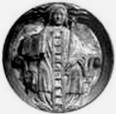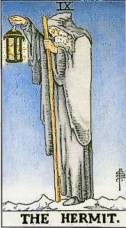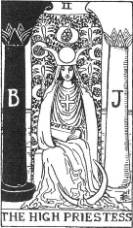Documento senza titolo
Philosophia
by Giovanni Lombardo
In the cathedral of Notre Dame in Paris, France, there can be seen a bas-relief which is commonly known as Philosophia (picture 1).
 It is possible the stonemasons were influenced by Boethius's De consolatione philosophiæ , which was written while he was imprisoned by Theodoric (1). In fact, the bas-relief's image is close to the woman that Boethius describes in his philosophical essay:
It is possible the stonemasons were influenced by Boethius's De consolatione philosophiæ , which was written while he was imprisoned by Theodoric (1). In fact, the bas-relief's image is close to the woman that Boethius describes in his philosophical essay:
While I was thus mutely pondering within myself, and recording my sorrowful complainings with my pen, it seemed to me that there appeared above my head a woman of a countenance exceeding venerable. Her eyes were bright as fire, and of a more than human keenness; her complexion was lively, her vigour showed no trace of enfeeblement; and yet her years were right full, and she plainly seemed not of our age and time.
Her stature was difficult to judge. At one moment it exceeded not the common height, at another her forehead seemed to strike the sky; and whenever she raised her head higher, she began to pierce within the very heavens, and to baffle the eyes of them that looked upon her. Her garments were of an imperishable fabric, wrought with the finest threads and of the most delicate workmanship; and these, as her own lips afterwards assured me, she had herself woven with her own hands. The beauty of this vesture had been somewhat tarnished by age and neglect, and wore that dingy look which marble contracts from exposure. On the lower-most edge was inwoven the Greek letter Π [Greek: P], on the topmost the letter Θ [Greek: Th], and between the two were to be seen steps, like a staircase, from the lower to the upper letter. This robe, moreover, had been torn by the hands of violent persons, who had each snatched away what he could clutch (2).
We are aware that esotericism is not a doctrine, but rather a method, so I strove to take Masonic teachings out of the picture: here are my thoughts.
* * *
In the bas-relief, the woman is sitting on a stone armchair. The stone alludes to the Nature's strength, firmness, which are the moral virtues of any profane who is seeking after Light.
She holds a book in her right hand and a staff, or a sceptre , in the left one. The right side is that of the reason, while the left one is that of the sentiment, and we fully understand because the book is on the right side.
The staff, or the sceptre , is an ‘axial' symbol, thus alluding to the axis mundi which ties up any creature to the Supreme Being. In a certain way it evokes the plumb, which is symbol of virtue and justice. It urges us to cultivate good feelings, to behave us at the highest levels of morality; the left side is therefore the proper one.
The staff pierces some clouds, that are seemingly hiding the heaven. In the past, man always thought heaven is the siege of God. Ancient Greeks believed that Zeus and the other gods dwelled on the edge of mount Olympus, which clouds hid; in Jesus' speeches there are many references to the Kingdom of Heaven. The divine siege was put in the loft, far from earth. In ancient Latin, heaven is cœlum , because cœlat , i. e. it hides the house of God.
Another ‘axial' symbol is the Hindu sūtrātmā , that is, the rosary. In the Bhagavad-Gītā man reads: “ Everything rests upon Me, as pearls are strung on a thread.” (3) Bro. Guénon comments upon it as follows: “It is Ātmā which, like a thread (sūtra), penetrates and ties together all the worlds, while at the same time also being the ‘breath' which, according to other texts, sustains them and keeps them in existence, and without which they could have any reality or exist in any way… Each world, or each state of existence, can be represented by a sphere through which the thread passes diametrically in such a way to form the axis joining the two poles of the sphere; thus, it can be seen that strictly speaking the axis of this world is only a portion of the axis of universal manifestation itself in its entirety, and it is in this way that the effective continuity of all states included in manifestation is established.” (4)
The staff therefore highlights the existing link between man and the Supreme Being, who can be known through Philosophia .
Incidentally, Middle Ages' idea of philosophy was different from the present one. This word embraced the whole secular knowledge, thus including the scientific one, but excluding the theology's domain. Man also thought knowledge was a means to gain wisdom, that is, the art of life.
* * *
In the middle of the bas-relief there is a ladder with nine steps. If the book and the staff symbolize the goals that initiates have to gain, that is, knowledge of the immanent and of the transcendent, respectively, the ladder points at the means: man has to gain knowledge progressively, by layers (the steps), so it urges him to be perseverant.
Number nine is thoughtful. Comedy's Paradise is figured as being formed by nine heavens; nine are the angelic hierarchies (5); in Vita Nova Dante affirms to have seen Beatrice for the first time when he was nine years old, and still after nine years for the second time (6). Incidentally, let me recall that Dante was member of Fedeli d'Amore , an initiatory society then existing in Italy and France. Beatrice is symbol of the philosophy. Dante therefore means that after nine years from his initiation he has reached a certain level, or “degree”, relevant to the knowledge or even to the wisdom: the so-called “Little Mysteries”; after next nine years, the Poet completed his initiatory path, gaining the “Great Mysteries”, relevant to metaphysics. Oddly, Italian literary critics refuse this interpretation, thus inducing students to believe Dante was a precocious Latin lover!
The Tarots' ninth Atouts is the Hermit: an old man who walks in the night, keeping a staff in his left hand and a lamp in the right one ( picture 2).
an old man who walks in the night, keeping a staff in his left hand and a lamp in the right one ( picture 2).
The Hermit is a card of introspection and analysis. This is not a time for socializing; the card suggests, instead, a wish for peace and solitude. Nor is it a time for action, discussion or decisions. It is a time to think, organize, ruminate, take stock. There may be feelings of frustration and discontent during this time of withdrawal. But such times lead to enlightenment, illumination, clarity. The Hermit represents a wise, inspirational person, friend, teacher, therapist: a true ‘master mason', we might say, who can shine a light on things that were previously mysterious and confusing.
* * *
The ladder lies on the woman's chest, on her heart, amid the picture. Mrs. Therese Darel wrote insightful words about the symbolism of the heart, to be considered as symbol of the centre:
The Heart, in our understanding, is the seat and the preserver of cosmic life. The religions that have made a sacred symbol of the Heart know this, as did the builders of cathedrals who erected the holy place at the heart of the Temple. They also knew it, who, the most ancient traditions, in the most secret rites, withdrew from discursive imposed silence on their brain to enter the Sanctuary and there to raise themselves beyond the relative being to the Being of being. This parallelism of the Temple and the Heart brings us back to the double mode of movement which, on the one hand [vertical mode], raises man beyond himself and disengages him from the process proper to manifestation and, on the other [horizontal or circular mode], has him take part in this manifestation in its entirety. (7)
* * *

There is also another picture on which I would like to draw your attention. It is the 2 nd Atouts of the Major Arcanes, the High Priestess, as depicted in the Waite-Smith version (picture 3). The Masonic influence is clear, although the context – and the meaning – of the card is different from the Philosophia's one. Anyway I found astonishing likenesses between the pictures, so one can infer that they deliver the same message. The High Priestess sits between Boaz and Jachin, the Masonic pillars. At her feet there is the crescent. In Hermeticism, the moon is relative either to mind, if it is waxing, or to sex if it is waning. The moon is at her feet: she has full control of her emotions. A cross is embroidered on her suit, amid her chest, thus stressing the heart as symbol of the centre (8). Her beret has two visors, that are alike the horns of a ram. This is an important feature. We know that in alchemy mercury symbolizes the mental activity, the communication, the intelligence. There are two signs which refer to it, as displayed below. The former points at the “vulgar mercury”,  that is, the ‘mental' – the crescent is on to the circumference – (picture 4); the latter, instead, is symbol of the “philosophical mercury” – the crescent being replaced by two horns – (picture 5). By this term alchemists pointed at the mental activity of the Adept who casts out his thoughts for the benefit of humankind. As an example, see the statue of Moses, by Michelangelo, in St. Peter's (picture 6).
that is, the ‘mental' – the crescent is on to the circumference – (picture 4); the latter, instead, is symbol of the “philosophical mercury” – the crescent being replaced by two horns – (picture 5). By this term alchemists pointed at the mental activity of the Adept who casts out his thoughts for the benefit of humankind. As an example, see the statue of Moses, by Michelangelo, in St. Peter's (picture 6).

* * *
By studying the symbol of Philosophia , I gained the following teaching: Freemasonry's aim consists essentially in reaching balance. We are taught to balance feelings an d thoughts, as we are reminded also by Boethius. His woman stays between θ , theorìa , and π , pràxis , that is, between “contemplation” – this being the true meaning of the Greek word – and “action”.
d thoughts, as we are reminded also by Boethius. His woman stays between θ , theorìa , and π , pràxis , that is, between “contemplation” – this being the true meaning of the Greek word – and “action”.
In The Freemason Bro. Eugen Lennhof wrote that Freemasonry neither is, nor cannot be the Holy Grail's knights' monastery. It is a society set up by men for other men. Freemasons are essentially builders, Golden Builders, as pointed out by Tobias Churton in his homonymous book (9). We read in the introduction:
So who are these ‘Golden Builders'? The title is taken from Blake's extraordinary poem and prophecy, Jerusalem (1804). Blake's ‘Golden Buiders' are building the city of Golgonooza, built from sacrifice of self (Golgotha) (10) and the basic stuff and substance (ooze) that is visible life.
I am aware there will be always some people that will judge it not enough and therefore will be longing for reaching lofty heights. For me, however, it's quite much.
Giovanni Lombardo
Notes:
1) Anicius Manlius Severinus Boethius. Roman statesman and philosopher, often styled "the last of the Romans", regarded by tradition as a Christian martyr, born at Rome in 480; was executed at Pavia in 524 or 525. Descended from a consular family, he was left an orphan at an early age and was educated by the pious and noble-minded Symmachus, whose daughter, Rusticana, he married. As early as 507 he was known as a learned man, and as such was entrusted by King Theodoric with several important missions. He enjoyed the confidence of the king, and as a patrician of Rome was looked up to by the representatives of the Roman nobility. When, however, his enemies accused him of disloyalty to the Ostrogothic king, alleging that he plotted to restore "Roman liberty", and added the accusation of "sacrilege" (the practice of astrology), neither his noble birth nor his great popularity availed him. He was cast into prison, condemned unheard, and executed by order of Theodoric . During his imprisonment, he reflected on the instability of the favour of princes and the inconstancy of the devotion of his friends. These reflections suggested to him the theme of his best-known philosophical work, the De Consolatione Philosophiae, Consolation of Philosophy.
2) Translated into English prose and verse by H.R. James, M.A., Ch. Ch. Oxford, Gutenberg Project.
3) Bhagavad-Gītā VII, 7
4) R. Guénon, The Chain of worlds , in Symbols of Sacred Science , Sophia Perennis, Hillsdale, New York 2004, p. 355
5) the treatise De Coelesti Hierarchia , which is ascribed to St. Denis the Areopagite , and which exercised so strong an influence upon the Scholastics , treats at great length of the hierarchies and orders of the angels. They are divided into three ternaries: Angels, Archangels, Virtues; Powers, Principalities, Dominations; Throne, Cherubim and Seraphim .
6) Vita Nova I and II
7) T. Darel, Vers l'Unité , July-August and September-October 1926, quoted by R. Guénon in Heart and Brain , in Symbols of the Sacred Science , p. 407
8) cf. G. Lombardo, The Cross , Lodge Room International Magazine, issue 09 2006
9) T. Churton, The Golden Builders , Boston 2005, p.xiv
10) Masonically, to smooth the rough ashlar